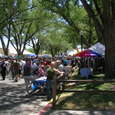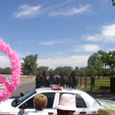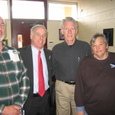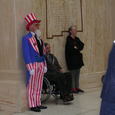« Tonight on We The People: DPNM Chairman Brian Colon | Main | Photo of the Day: Rose Bowl Parade Protests »
Wednesday, January 02, 2008
Finally: Hawkeye State Caucuses Set for Tomorrow
Has the campaigning leading to tomorrow night's Iowa caucuses been going on for years? Feels like it to me. I imagine it feels even longer to those who've been working the state for so long. If I hear the phrase "latest polling shows" one more time, I may start screeching. Polling, schmolling -- the truth is that nobody really knows what will happen when Iowa Dems (and many Independents) gather in 1,781 precinct meetings across the state to choose a favorite among Democratic presidential candidates. In the last analysis, it's a roll of the dice in many ways.
An optimistic projection of how many will show up to participate in the Dem meetings would equate to about 25% of those eligible, or about 150,000 people. In my view, this relative handful of folks has managed to accumulate way too much clout in designating the front-runners in the race. Iowans obviously don't think so. It must be nice to be courted so carefully by all the candidates, and the state's hotels, restaurants, TV stations and other businesses benefit mightily from the months of campaigning. Unfortunately, as Markos lays out in this post on Daily Kos, the Dem caucus process in Iowa is also very undemocratic and elitist. Not a good way to pick a nominee while the rest of us sit here on our hands.
Viable or Nonviable
Besides turnout, one of the critical factors in determining whether a candidate will have a strong showing is to whom the supporters of "nonviable" candidates will turn as a second choice. If a candidate gets less than 15% or so of those attending a precinct caucus, they're deemed "nonviable" and the candidate won't earn any delegates from that precinct. The supporters of a nonviable candidate can either walk away without their votes counting for a particular candidate, or switch to another candidate who has passed the viability threshhold in that precinct. That's where all the wheeling and dealing comes in, and candidates who have strong organizations at the precinct level can sometimes work wonders in convincing caucus-goers on the spot to pick them for a second choice.
The nonviable candidates in a precinct can also have a powerful influence in the second choices of their supporters. For instance, last time out in Iowa in 2004, Dick Gephardt encouraged many of his supporters to switch to Kerry in precincts where he wasn't viable. Kucinich urged his supporters to go with Edwards. This year, Kucinich has announced that he'd like his voters to move their support to Obama as a second choice. This post on Wampum provides an excellent dissection of how the process works, written by someone who was a convenor at similarly structured caucuses in Portland, Maine in 2004.
Will Richardson Urge Supporters to Pick Hillary as Second Choice?
I'll be very interested to learn where Bill Richardson will point his supporters in precincts where he's not viable. If he urges them to move into the Clinton column, we can surmise that his strongly antiwar strategy may have been waged, at least in part, as a sort of stalking horse effort to gain supporters who might ultimately benefit Hillary. He'd be taking votes from Obama, Edwards and other antiwar candidates if he sends them to Clinton despite her unapologetic vote for an Iraq invasion.
Clinton can use all the second choice votes she can muster. According to a column by Charles Hurt in the New York Post:
Heading into the final day of campaigning before Iowa votes tomorrow, Hillary Rodham Clinton still faces one of her thorniest problems in her bid for the White House. Although she has a considerable base of devoted fans in Iowa, she is not well liked by those Democrats supporting other candidates.
Of the other Democrats who plan to caucus tomorrow and vote for other candidates, Clinton is the second choice of just 15 percent, according to a new poll. Barack Obama is the second choice of 22 percent and John Edwards is the second choice of 30 percent of Iowa Democrats, according to the Reuters poll.
If Richardson should decide to urge his supporters in his nonviable precincts to support Clinton -- and they follow his recommendation -- he could become a sort of kingmaker in terms of bolstering Clinton's numbers. We all know how close Richardson has been to the Clintons during the course of his career in Washington. Bartering at the precinct level might also help Richardson's chances for being selected as Hillary's VP candidate, or of earning a plum appointment should Hillary become our next President. Definitely something to watch for if the Richardson campaign's of a surprisingly strong showing for their candidate turn out to be just wishful thinking.
Small and Large Precincts Can Have Similar Clout
Another oddity in the Iowa Democratic caucuses is that it's beneficial to have support throughout the state's 99 counties and 1,781 precincts. Because of a complicated system used for apportioning delegates, a candidate gets no extra benefit from overwhelming support in a given precinct. In other words, caucus meetings with few participants in rural parts of the state can sometimes wield about as much clout in terms of delegates earned as larger urban caucuses with many more attendees.
Something to keep in mind: No candidate finishing worse than third in the Iowa caucuses has ever gone on to win their party's nomination. One thing is certain -- Gov. Bill Richardson and his supporters have worked their butts off in Iowa. We'll finally get to find out what all those hours of sweat equity will bring on what's forecast to be a bitterly cold winter's night in Iowa.
*Photo of Bill Richardson by David Negrete. Click on image for larger version.
January 2, 2008 at 02:47 PM in 2008 Presidential Primary, Democratic Party | Permalink









